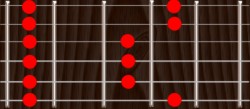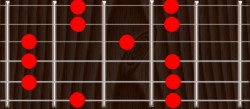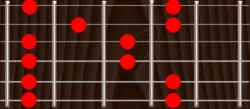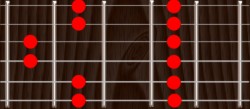A. Five Positions Of The Pentatonic Minor Scale
This lesson will cover learning the five positions of pentatonic minor for guitar and bass. Below you will see the full version of the E pentatonic minor scale, showing where each position should be played in E pentatonic minor on the guitar. You can also see where all of the root notes are on the full diagram of E pentatonic minor.

* Note that the positions overlap, for instance position two is simply the top half of position one mated with the bottom half of position 3.
All of these positions fit together perfectly and will always be in the same order that they are here. That means that they must always be positioned together as they are and their relation to each other will never change. To play this pentatonic minor scale in any key other than E, you would have to slide the whole note diagram up or down the neck, moving all the positions together. This will be covered in the transposing scales lesson.
Now that you can see all of the positions and how they work together to form the E pentatonic minor scale, I will show you the individual positions. You will notice that there are no marks on the notes in the position diagrams to show where the root note is as this is not important for the positions. We will find out why this is when we get to the lesson on transposing.

Position One

Position Two

Position Three

Position Four

Position Five
Now we can move on to start learning how to use this in your playing. The next section is on "phrasing" and will teach you how to play this scale with feeling and start improvising with it.
Recommended Books On The Pentatonics

- Jazz Guitar Soloing Concepts : A Pentatonic Approach to Improvisation - Learn an entirely new way to improvise over jazz changes This hefty book/CD pack sheds new light on the old five-note scales that all guitarists know and love. The system is theoretically sound, easy to implement, and best of all, it's designed specifically for guitar. It will work with any chord progression - from simple to complex and, unlike other systems, there are no notes to avoid.
B. The Art Of Phrasing With Pentatonic Scales
Phrasing is the way we will think of how we play the guitar or bass. Its almost like English class in school, in that we will think of it like the way we speak. After all, that is what you want to do with your instrument isn't it? We will learn to express ourselves and our playing using phrasing.
Phrasing terms :
- phrase: A phrase is a group of scale notes being played together to form a musical "idea".
- period phrase: A period phrase is a phrase that ends with the root note. This leaves the listener with a sense that the idea is done or complete. It has a "finished" sound.
- comma phrase: A comma phrase is a phrase ending in a note other than the root note. This leaves the listener with the feeling there must be something more to come. The idea does not sound "finished" yet.
- phrasing: This would simply be the art of phrasing and using both comma and period phrases together to form whole solos, etc..
Each lick, riff, or melody you play we will call a phrase. Some phrases are comma phrases and some are period phrases. When we link comma and period phrases together we get ideas that are more complete. So a whole entire solo would be just like a paragraph. Lots of smaller ideas linked together, using comma and period phrases that kinda make up sentences, and those all put together will kinda make a paragraph (or for you a solo).
It does not matter what scale note you start a phrase on, only what note the phrase ends with. This all rests on knowing what key you are playing in. To be able to hear this comma/period phrasing at work much better, you need to hear the root note often. Say, if you are playing E pentatonic minor scale notes it would help to hear an E minor chord (your root) fairly often. Also, playing with a CD or some song that you know uses your scale would help tremendously. This allows you to hear the way a phrase ending on a root note sounds finished, and a phrase ending on a note other than the root note leaves it sounding like more must be coming.
Try it out. If done properly you will hear what I am talking about.
Recommended Books On The Pentatonics
- Pentatonic Scales for Guitar : The Essential Guide (With CD) - This book provides the pentatonic scale fingerings, diagrams, lessons and licks that every guitarist needs to know. It covers major and minor pentatonic scale patterns in all positions; licks in the styles of Eric Clapton, Jimi Hendrix, Jimmy Page and many other great artists. The CD includes 90 full-band demos for listening and/or play-along. The book is in standard notation and tablature.
C. Transposing Scales Into Other Musical Keys
Ok, so what happens if you don't want to play pentatonic minor in the key of E ? Well, now we would have to transpose the scale into another key. Transposing simply means to move our scale, moving all of the positions together, to another key or root note.
If you wanted to play A pentatonic minor instead of E pentatonic minor, you would have to move the first position that starts with the low E note up 5 frets so that the first note of position 1 is the A note. All other positions would have to slide up the neck 5 frets also, so that their relation to each other is still the same. Naturally, anything that slides up past the octave (12th fret) will also appear at the bottom of the neck, as they are the same notes.
If you have already learned E pentatonic minor (and you should have if you are here) you can study the diagram below and you can see exactly what I am talking about. Our root note will now be A, and that's where the first position will start.

Notice that even the root notes are in exactly the same place in the positions as they were before, the only thing that's changed is we slid the whole thing up 5 frets.
You would now be playing "A pentatonic minor".
I hope this lesson is helpful to all of you. I keep practicing my major scales every day and it has helped my overall guitar skills incredibly. Now I’m working on The Pentatonic and Pentatonic Minor Scales since I’m concentrating on my blues skills; I suggest each of you do the same and as you play, your guitar skills will improve more and more. I hope you found this post educational overall.
Until next time ~ ~ ~
Musician By Night . . .




I am not sure where you are getting your information, but great topic. I needs to spend some time learning much more or understanding more. Thanks for excellent info I was looking for this info for my mission.
ReplyDeleteMendini MPT-N Nickel B Flat Pocket Trumpet w/ Case, Accessories & Chromatic Tuner with Metronome